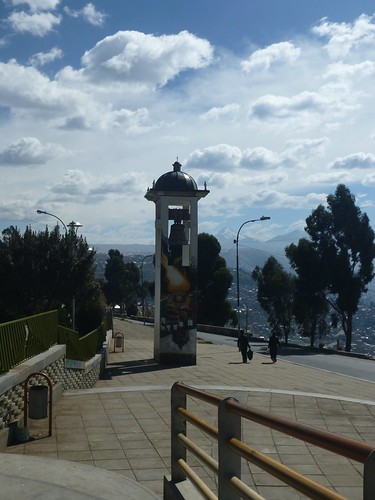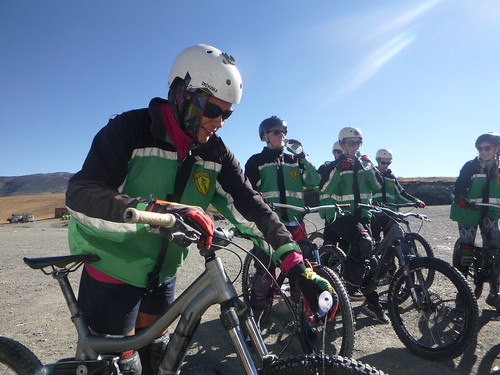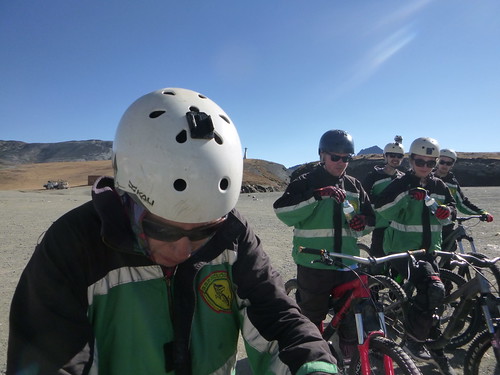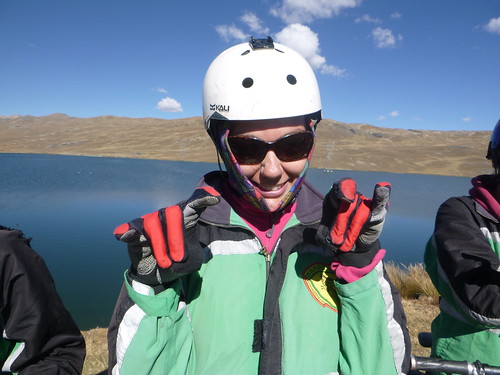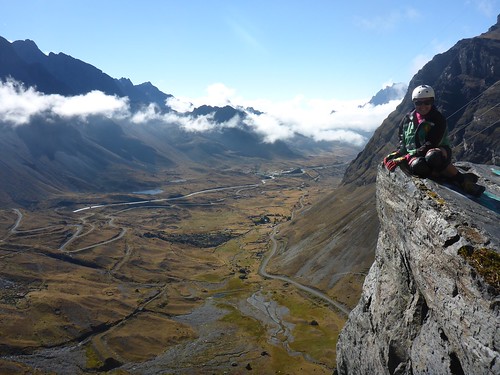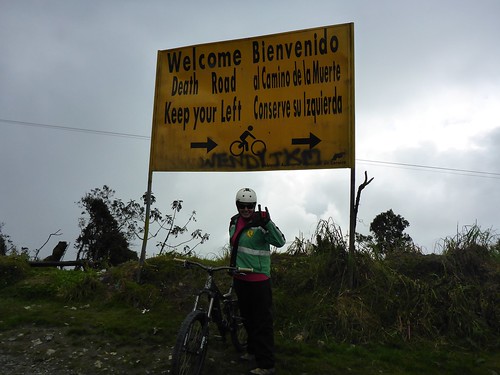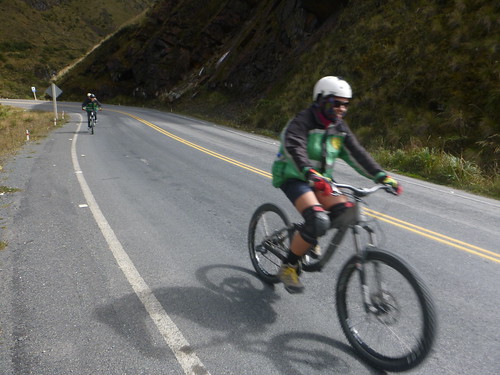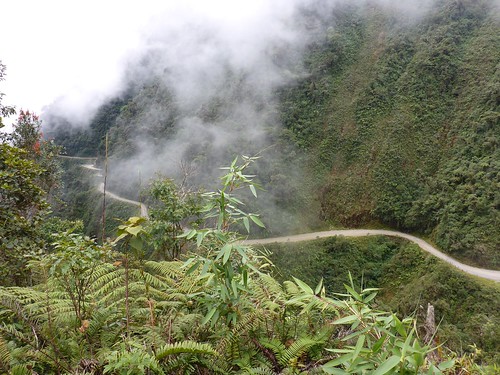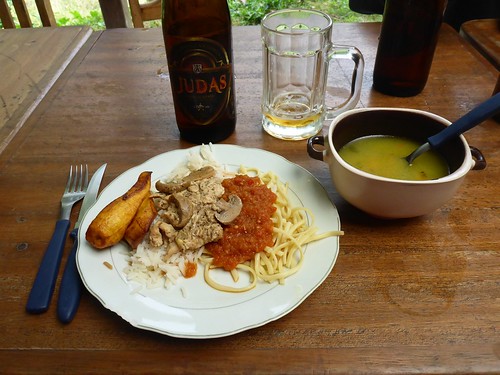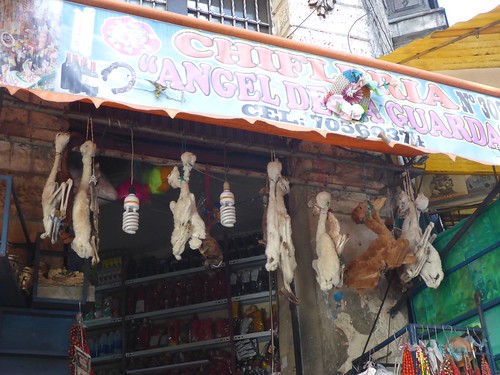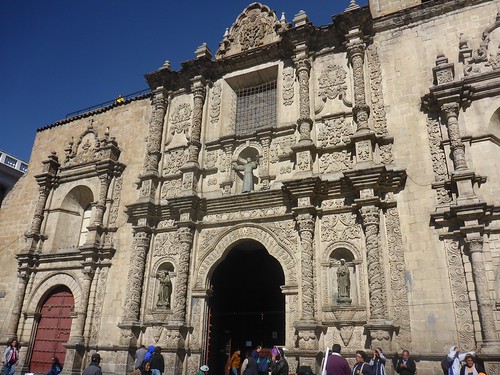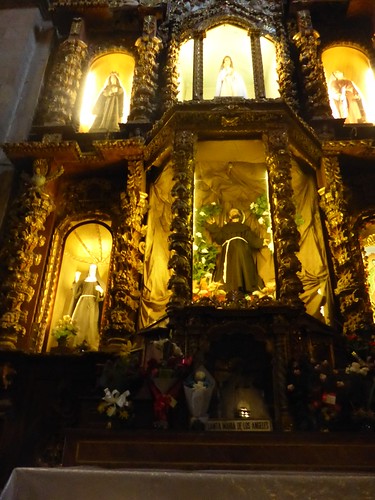La Paz, formally La Ciudad De Nuestra Señora De La Paz (“The City of Our Lady of The Peace”), is the highest administrative capital in the world. Not the highest actual capital, since Sucre is legally Bolivia’s capital, but it is the one where the government is.
The overnight bus from Uyuni to La Paz was pretty uneventful, most of the trip was us attempting to sleep through the numerous stops on the way, with nothing much to look at. The bus was supposed to arrive at the main terminal in La Paz at 8am, but it arrived much earlier than planned, and came in at 6am instead. Normally, arriving ahead of schedule would be a good thing, except that this time it was much too early in the morning for us to be able to check in to our hostel. Sometimes the private rooms we have booked are free so they let us go in early, but this time we had chosen to stay in a dorm room.
In La Paz, we chose to stay at one of the larger hostels chains in South America called “Loki”, which is well known for partying and mayhem. Before heading there, we thought we should have a coffee at the bus terminal, which turned out to be one of the worst instant coffees we had experienced in South America, the flavour of cold watery dirt.
The arrival at Loki’s reception was a descent into chaos, full of people trying to check out so they didn’t miss their bus to other cities, people checking in, people waiting to go on tours, and some that just appeared to be too drunk to remember where their room was. There was not enough staff there to deal with everything that was happening, so we had to wait in what could be loosely termed a line - if you tried drawing that line after three bottles of whisky and some Bolivian marching powder.
We eventually managed to talk to one of the staff, after being cut off by a few groups of people pushing in, and were asked to go up to the first floor to put our bags into the storage room and wait until check-in at 2pm. Loki had the largest luggage storage area we have seen anywhere, about 10 meters by 15 meters, with floor to ceiling racks holding backpacks, and piles more on the floor. We put ours near the door hoping that would help us find them again, and then headed up to the bar-cum-restaurant on the seventh floor to get some breakfast.
There was quite a large menu to choose from, although not that cheap, and since we didn’t get much sleep on the overnight bus, and we couldn’t shower (as our bags were packed), we decided to spend the day admiring the view from the top of the building. Definitely admiring the view, and not making friends over a beer or five (surprise!).
When two o’clock finally rolled around and it was check-in time, we headed back down to reception, only to be told that our room hadn’t been cleaned since the old residents had left and we needed to wait longer. With no specific time to wait, we did the only sensible thing and headed back to the bar. Checking in periodically (about every second beer), our room continued not to be ready, until finally at 6pm we could go and see what our first dorm stay of the trip would be like.
Numerous trips up and down the stairs does not sound that hard, but we were exhausted and at 3650 meters above sea level, every flight of stairs takes it out of you; the elevator was often full and it stopped at the second last floor as well.
On many one of the trips down to reception we stopped in to the tour desk, so that Dee could organise to ride down Camino de Muerta (“death road”) on a mountain bike the next day. The last time James rode a bike he was about 8 or 10, so thought that if he tried then the name of death road could become a reality for him or someone he ran into.
After the big day of doing nothing, we decided to have a quiet night in with dinner at the hostel, or as quiet as Loki ever is. For the poor people on the floor below the bar on the sixth floor, the quiet probably began around 2 or 3am. Luckily we were on the fourth floor, so our issues with noise were from our roommates, who at midnight decided to turn all the lights on and have a very loud conversation for the next hour. At this point, we started to wonder if the foray into dorm rooms was a bad idea.
James visits El Alto
Monday, our first full day in La Paz, was one of the few that were spent almost completely apart - with James exploring the city and Dee riding down Death Road.
After a late breakfast at 9am, James headed out of the hostel and up to La Paz’ teleferico (cable car), to get a nice view from the city of El Alto. The map only shows the station as a short walk from the hostel, and the 8 blocks isn’t that far, except for the fact that it is all walking up-hill at altitude. The teleferico is a great idea, providing cheap transport (under $0.60 AUD) for the locals in the city, and a great view for tourists. So great is the idea, that they are have already started construction for the expansion from two lines to five.
El Alto (“the high city”) is the main conurbated city of La Paz, and as the area is very flat as compared to the valley of La Paz, it is where the airport is located. Being over 4000 meters above sea level means that the runways are over 4km in length and it still cannot deal with large aircraft like 747s. Taking off from the airport, as James did in 2010, is an interesting experience and may not be enjoyable if you are scared of flying.
When you arrive at the teleferico station in El Alto, you walk out onto the street and immediately feel that you are in a true Bolivian city. There are cars all over the place and piles of rubbish sitting there, everyone is trying to sell you things, and locals are rushing around going about their business. Near to the station is the location of the El Alto black market, but unfortunately we missed it since it is only on Sundays and Thursdays. That may not have been such a bad thing, since the market is not a safe area for tourists, with many reports of pick-pocketing and aggressive robbery, and that happened to two people we met.
As a tourist, there is not very much to do in El Alto, apart from take a few quick photos and walk across the road to see the view over La Paz. There are no constructed viewpoints, so you need to stand on the side of the highway going out of La Paz with barely anything stopping you from falling down large cliffs.
Heading back down the teleferico (another whole 60c!), James went for a walk around the inner city to see what it had to offer. For whatever reason, all the shops that sell one kind of item or service are located near each other, so he headed down bed linen street, turned down chicken street, and then along mattress street. Going past our hostel (on optometrist street), he went over the main road through the centre of La Paz and ended up at the Plaza de Armas. In the block approaching the plaza, there were large fences guarded by military police. We have no idea what they were guarding against, but it obviously wasn’t inquisitive tourists. The plaza was nice, and we learnt more about it the next day. James headed back to the hostel, and quick beer, to wait for Dee to return.
Dee rides Camino de la Muerte (Death Road)
For Dee, the morning didn’t start quite as late or relaxed as James’. The alarm was set for 6am so that I could get to the restaurant where I was to meet the tour group. I’d organised with Kristy and Josh, whom we’d met across the salt flats, to go on the same tour as them so that I had a little company since James apparently doesn’t know how to ride a bike (I secretly suspect that he does, but just doesn’t want to!). Tucking into some eggs and a bucket of coffee at the restaurant, we were gathered into groups and put onto minibuses stacked with our bikes. We drove for half an hour or so to a dirt patch on the side of the road with a lake and a brick wall, disguised as a toilet. The bikes were unloaded and all necessary adjustments made, including a quick change of sides for the brakes. Not only do they drive on the wrong side of the road here, the brakes on the bikes are on different sides as well… on top of this, the drivers in Bolivia are completely insane and have no care for anyone else on the road whatsoever. Our tour guide, Gus, gave us a quick crash course on how to use the bikes, explaining the suspension system and the sensitivity of the brakes. We then needed to pray to Pachamama (Mother Earth) for our safety, included in this prayer was a quick sip of 90% alcohol to calm the nerves, not quite the start we were expecting to the 58km journey we were about to embark on.
The ride started on a 22km downhill run on asphalt, this part of the trip was not quite death road but the nerves of it all were starting to kick in. Trucks, buses, insane car drivers and the occasional other bike group fly down the mountain; the other bikes would let us know they were coming, the vehicles on the other hand seemed to try and drive as close to us as possible. Stopping at a few points on the way for a little information of what to expect next, water and a couple of photos, we eventually made it to the beginning of Death Road. Fortunately all of our group were able to listen to Gus’ instructions before heading down the hill, particularly the part about making sure we don’t hit the brakes too hard otherwise we’ll flip over the handlebars… a lady in another group didn’t fare as well on the asphalt; having come off her bike, breaking her jaw, losing a few teeth and hitting another cyclist who then broke her arm. One would hope they had travel insurance!
It took me quite a while to get my nerve up on the bike and start heading at a reasonable pace to keep up with the group. Although it hadn’t been too long since I’d ridden a bike, I had never dealt with the maniacs that are Bolivian drivers, or a proper downhill mountain bike on the road. Once arriving onto Death Road we were given very specific instructions not to ride against the cliff wall, instead to keep left: directly beside the multimeter drop-off that gave death road it’s name. Heavily armed with a bike helmet and kneepads (I can assure you, these weren’t going to save me going over the edge), it was time to fly down the rocky narrow road, and hope that no cars would be travelling along it.
On the trail down we narrowly avoided larger rocks on the road, travelled around tight corners with hidden holes to the emptiness below, through waterfalls and down a few steep bits, stopping every 4-5km to regather our thoughts. Along the way we learnt about the numerous deaths on the road since it had originally been built; though it’s not used much by cars anymore as another more sensible road had been built, there are still deaths occurring, the most recent in March this year. The importance of listening to the instructions was highlighted by a few of the stories Gus shared with us along the way.
Here was the point that our group had realised how steep the drop was from the road… we were told to sit on the edge and hang our legs over. This particular ledge was one that many people in either cars or bikes had falled off the edge of - including a bus of 18 school children and their teachers (this may not have been precisely at this point, but the rest of the road was just as narrow and as steep as this spot). Hanging our legs of the edge here was slightly terrifying.
Where they filmed part of the Top Gear episode
Yes, that’s a cray hairpin switchback turn, and everyone was close to dying.
A total of 36km of down-hill mountain biking later, we’d made it into a small town at the bottom where we were promised a shower and lunch. By the time we’d made it, majority of us were starving, sweaty and covered in mud. After getting cleaned up it was well and truly time for a beer to sort out the last of the nerves and the adrenalin running through my body. As a group we sat down to a meal of soup and pasta with a bit of chicken, a fairly simple affair but filling.
This meal lead to food poisoning :(
It was time to get back on the bus for the four-hour trip to La Paz, unfortunately we needed to stop a few times along the way back to get more beers (such a shame!), as well as a few toilet stops in the middle of nowhere. The drive back was nearly as dangerous as Death Road itself, there was little visibility due to a large amount of fog rolling in, as well as the usual trucks and buses driving on the wrong side of the road. It was definitely time for bed when we’d arrived back into La Paz; the ride was amazing but very exhausting!
Back to La Paz
On Tuesday we were greeted with new roommates, and thankfully it appeared that they were much more considerate than our previous ones; although La Paz is not somewhere that you can easily sleep in past 6am. Most buses either arrive or depart sometime around then, and many of the day tours offered also start before 7. For most of Tuesday we spent time at the hostel, chatting with people, catching up on admin work (planning and the blog), and for Dee recovering from Death Road - there was definitely a bit of sore bum happening! For lunch we decided to visit a Mexican place with Kristy and Josh; it wasn’t the cheapest of places but had good recommendations and pretty delicious food.
After eating our weight in Mexican food, we walked to the witches markets that were only a few blocks from the hostel. There were a lot of weird and wonderful things at the witches market, including llama foetuses (a little creepy), many herbs, and a multitude of crazy ladies trying to sell tea, assorted types of powders, and incense sticks. Along with the crazy shops, there were a few people walking around selling street food (usually empanadas or hamburgers) and different types of juices. Bolivia is a place where street food is readily available and it all looked amazing; we had however been warned that the lack of running water, electricity, and any kind of safe hygiene practices, which could reek havoc on backpackers. We decided that while we were in La Paz, we should play it safe and eat at proper restaurants in an attempt to avoid too many upset stomachs. Unfortunately for Dee this tactic worked against her, by the end of the day something had curled up and died in her stomach. Thankfully Dr. Deb the travel doctor gave us a pile of amount of stomach bug killers and other bits and pieces to help out.
On Wednesday we decided to ignore the fact that both of us had gotten very little sleep, and head out on a free city walking tour. Most of the major cities we have been to so far offered free walking tours (on a tip basis), and were usually fairly informative and interesting.
The walking tour started with the San Francisco cathedral, the oldest in La Paz. Rather than dominate the locals as most groups did, the San Franciscans tried to make friends with the locals, and invited them to help construct the church. This lead to some quite unusual features, such as a naked woman giving birth beside San Francisco (fertility is important to the indigenous cultures), and there being a set of staring faces carved near the entrance. The faces are the spirit guardians for the church, and there are also coca leaves carved next to them to keep them awake and ensure that the church is not left unprotected at night,
When the indigenous people chose not to convert to Catholicism, the Spaniards decided that more persuasive means were needed, and constructed a large alter containing mirrors that they imported from Spain. They told the locals (who had never see a mirror before) that their souls were now trapped in the church, and that if they did not come pray every day, their souls would not be released upon death. The original 14 meter gold altar is still in the church there, and is worth around $40 million US dollars. Unfortunately, Dee had not recovered from here stomach issues of the evening before, so decided to head back to the hostel.
The tour group then went for a brief look at the Witches markets, which we had seen previous day. The local belief is that the God of Thunder and Wisdom grants knowledge of magic, so to become a witch you have to be struck by lightning and survive. It can also be passed down to the first-born daughter, so if you asked a female witch if she was struck by lighting and says no, then she much be a first daughter of a first daughter up the line to someone who was. If you find a male witch, then they have to be struck personally so would usually show you the scars to prove it. One of the most important things that they sell are dead baby llamas and llama foetuses, which are supposed to die of natural causes. The most important ceremony they are used in is to bless a new house. Even if you do not believe in witch magic, you must have the ceremony performed; otherwise the workers who do believe will refuse to build your house.
Around the city there are a lot of Cholitas, women dressed up in “traditional” costume. It is not actually an indigenous costume, but how the aristocratic Spanish women dressed during the period of colonisation. Any indigenous women who had enough money to do so chose to dress like them, so as to appear wealthier. Spanish fashion changed, but the Cholitas kept wearing the same style of clothing. A good quality outfit can easily cost $6000 US dollars, with the hat alone being over $400.

Our guide told us that the unions in Bolivia are extremely powerful, and every job has one - even the shoe-shining children who are below the legal working age have their own union. An example is the union for people who sell clothing and trinkets to tourists, and they have two important rules. First is that they cannot lie about the quality and makeup of items, if they get caught claiming that a jumper is 100% llama wool and it’s only 50%, the union will shut down their shop for a few days as punishment. Second there are minimum and maximum prices for items, and although tourists obviously pay more than locals, there are limits and if someone is caught charging tourists too much, they will be fined and shut down for a few days as well. The idea of those two rules is to prevent tourists from being scammed and then telling everyone not to buy things in La Paz.
Another unusual fact is that due to the number of markets and street sellers, there are virtually no supermarkets. Greater La Paz has a population of 2.3 million and only 20 supermarkets, and the city of El Alto has only one single supermarket for it’s million people. Consumers and sellers form strong bonds here, if you buy some kind of fruit such as a few oranges from one lady, you don’t dare buy some fruit such as bananas from another one (at least not within line of sight). After a while you refer to your vendor as “casera” (meaning you consider them part of your home life) and you can get better deals. Food is the one thing you don’t barter price on, since it is almost always grown or produced by the seller, and so saying that it is not worth the money would be offensive. Instead of bartering for a better price, you instead ask for “yapa” and get a bit extra for free.
The tour then walked down to the San Pedro square, adjacent to the infamous San Pedro prison that became well known from the book “Marching Powder”. The prison is unique in that the government lost control of it in 1982, and it has chosen to let the prisoners remain in control since that day. There are guards outside to ensure no-one escapes, but none inside in the prison. The prisoners elect their own mayor every two years, the prisoners pay “rent” for their cells (from 50Bs/$7US a month for tiny shared cells, to $1500USD for fancy ones with a hot tub), and they produce craft items that their family sell on the outside. Aside from not costing the government any money to run, it also appears to teach the prisoners how to behave in a society. As a result, they tend to merge in well when released and be much better behaved than those who are kept in other prisons.
The traffic in La Paz is a bit crazy, especially around the city centre, but the last time a pedestrian died was in 2001. The guide said that the government started paying 15-year-old children to dress up as zebras to teach people about “zebra” pedestrian crossings. Due to the levels of corruption, police here are not well respected, so if they catch you crossing against the lights, people make up an excuse of being busy and keep going. If a “Zebra” sees someone jay walk it, they tell them off, then everyone will stop and not cross - the children dressed up as Zebras have much more respect from the locals than the police do!
Next we went up to the main square, which at one stage was the main square of the Spanish Empire in South America. Overlooking it is the Congress building, which has an unusual clock that runs anti-clockwise. The government made the change without any announcement, and noone knew why it went backwards for some time, with several government ministers giving made up explanations and conflicting stories. Finally the government gave the real reason: in the Southern hemisphere sun dials go the other way, so clocks should too. They asked the other governments in South America to do the same, and they got laughed at. The only one who made a similar change was Venezuela, which doesn’t even make sense because that country is in the Northern hemisphere.
The old presidential palace also looks over the square, but no president has lived there since 1946 due some very nasty events. The government at the time was repressive of the people and there were many protests and riots going on, which were usually squashed with extreme violence. One night a group of protesters broke in to the palace and murdered the president in his sleep, and then dragged his body outside to the square and hung it from a lamp post for 10 days as a warning to future presidents not to oppress the people of the county. Since then the president has lives 2km away, obviously with much better security.
On the buildings are three flags, the main Bolivian flag, Wiphala, which is the flag of the indigenous people, and the Bolivian Pacific Department flag. Bolivia lost it’s coastline in the war with Chile over 100 years ago, but they are still fighting Chile in international courts to try to get the Pacific port which was promised to them in the peace treaty. The International Court of Justice ruled last September that Chile had to give Bolivia the port as promised, but Chile just moved army troops to the border and said “you lost your coast in a war, if you want it back then you’ll need another war”. Since Chile’s armed forces are several times more powerful than Bolivia’s, Bolivia obviously chose to pursue this through international legal means rather than fighting. Bolivia is unusual in that both the main flag and Wiphala are official flags, which means that it is the only country in the world with two official ones.
The main cathedral of the city also overlooks the square, and parts of it keep falling down. After reconstructing it 8 times, they gave up and left it broken. Years later Pope John Paul II came to Bolivia, and the government thought it should repair the building yet again since a pope visiting was such a great honour, spending a lot of money in doing so. The pope arrived, looked inside for a few minutes, and then left in his pope mobile. The people were so angry that they had made such an effort to fix the cathedral for a 5 minute visit, they added a satirical plaque announcing the work put in for such a short visit by the pope. When Pope Francis visited recently, he knew the history of this and gave a three and a half hour mass inside, and on the way out stopped to read the plaque and laughed out loud.
Finally we walked past the base camp of a protest group, which is a very common sign in Bolivia. There are on average 8 protests a month in La Paz, with lots of fireworks and tiny TNT charges being set off. In most countries people try to negotiate with the government, and then protest if that fails. Here they protest for a few days, and then sit down to negotiate with the government second.
Once James arrived back into the hostel, we decided that we probably needed to start packing as our bus the next morning was due to leave at 6:30am. As we’d finished packing we were greeted with another new roommate, Gary, who had just arrived back from volunteering at an animal refuge. We decided to head upstairs and grab some dinner whilst sharing stories of our trips so far, including all of the funny bits and pieces we’d seen or learnt along the way.
Cruising in for another early night we set the alarm for stupid o’clock and called lights out. We were more than prepared for the bus trip by the time morning came; we’d even managed to get ourselves checked-out in a reasonable time. We have become accustomed to the buses running on South American time on this trip (so somewhere between 15min and 1.5hr late), it was a surprise to have the Bolivia Hop bus turn up at exactly 6:30 - unfortunately not everyone else going on the bus was so organised, so we were delayed by 20 minutes. We jumped on, got some of activities and plans with PeruHop sorted out and got ourselves excited for another Copacabana (not the one in Rio!).
Go see all the photos from La Paz and Death Road

